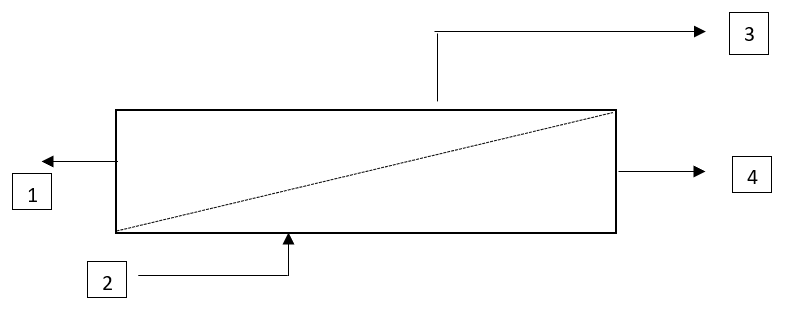This set of Bioseparation Engineering Multiple Choice Questions & Answers (MCQs) focuses on “Membrane Separation”.
1. A membrane is understood as ____________
a) thin barrier
b) thick barrier
c) semi thin barrier
d) semi thick barrier
View Answer
Explanation: A membrane is understood as a barrier which is thin and semi-permeable. It will separate the products selectively on the basis of various factors.
2. Membrane can be used for separation of ___________
a) particle separation
b) particle-particle separation
c) particle-solvent separation
d) particle-solute separation
View Answer
Explanation: The membrane can be used for various separation types including particle-solute separation along with particle-liquid separation as well as solute-solvent separation, solute-solute separation.
3. The applications of membrane includes ___________
a) product concentration
b) solute concentration
c) solute removal and Product concentration
d) solute removal
View Answer
Explanation: The applications of membrane includes product concentration along with product sterilization in which removal of microbes takes place; fractionation of solutes, desalination as well as demineralization i.e. solute removal from the solution mixture.
4. The factor used in membrane based separation is ___________
a) solute size
b) solvent size
c) solution size
d) feed size
View Answer
Explanation: The factors used in membrane based separation include electrostatic charges along with solute size. It also includes diffusivity and solute shape used in the separation process.
5. The material transportation through the membrane is driven by ____________
a) diffusion
b) convection
c) diffusion and convection
d) convention
View Answer
Explanation: The transportation of material can be processed to membrane by methods like diffusion and convection, both in the form of single method as well as combination of the method. The combination of these two methods are more fruitful for many processes or depending on various parameters.
6. Convection based transport takes place due to ___________
a) trans membrane pressure
b) pressure drop
c) movement of sample
d) charges
View Answer
Explanation: The process of convection takes place because of the pressure developed in the trans membrane and this causes the membrane to process the separation process involving the transport of the particles through convection.
7. Which process of transportation in membrane separation is considered to be pressure driven?
a) particle–particle separation
b) solute size
c) convection
d) diffusion
View Answer
Explanation: The process of convection is known as pressure driven process because it takes place due to the pressure developed in the Trans membrane during the separation in the bioseparation engineering.
8. Label the given diagram.

a) 1. Feed 2. Permeate 3. Retentate
b) 1. Feed 2. Retentate 3. Permeate
c) 1. Permeate 2. Feed 3. Retentate
d) 1. Retentate 2. Permeate 3. Feed
View Answer
Explanation: Feed enters the membrane module and crosses the membrane then it is separated into permeate and retentate. The permeate moves straight from the module and is collected for further use and then the retenate is collected separately.
9. Diffusion based transport takes place due to ___________
a) electrostatic charge
b) diffusivity
c) solute shape
d) pressure
View Answer
Explanation: The process of diffusion is based on the diffusivity of the particles being separated through the membrane. Since the membranes are selectively permeable therefore they separate the sample baed on the diffusivity.
10. Diffusion based transport utilizes ___________
a) concentration difference
b) pressure difference
c) size difference
d) shape difference
View Answer
Explanation: The driving force for the process of diffusion in membrane based separation is the difference of concentration in the medium which is the part of the transported species.
11. Label the given diagram.

a) 1. Feed 2. Sweep 3. Retentate 4. Permeate
b) 1. Sweep 2. Feed 3. Retentate 4. Permeate
c) 1. Retentate 2. Feed 3. Permeate 4. Sweep
d) 1. Sweep 2. Permeate 3. Feed 4. Retentate
View Answer
Explanation: The feed enters along with the sweep in the membrane module and then the separation takes place and finally the retentate as well as permeates are separated and collected separately.
12. A membrane can be made of ___________
a) polymer
b) inorganic material
c) organic material
d) polymer or inorganic material
View Answer
Explanation: The membrane can be made of many different substances and majorly it is made up of either polymers also considered as organic material and inorganic materials.
13. The polymer used in the making of membrane includes ___________
a) cellulose
b) plastic
c) ceramic
d) iron
View Answer
Explanation: The plastics are not used in the making of membrane as they doesn’t have the separation properties. Ceramic and iron are not the organic material so they cannot be the part of polymer for making of membrane.
14. Polysulfone is the polymer used in the making of membrane for the separation process.
a) False
b) True
View Answer
Explanation: Polysulfone along with other organic material like polyethersulfone, cellulose acetate, polyamides and polyvinylidine fluoride are the polymers used in the making of membranes for the process of separation.
More MCQs on Membrane Separation:
Sanfoundry Global Education & Learning Series – Bioseparation Engineering.
To practice all areas of Bioseparation Engineering, here is complete set of 1000+ Multiple Choice Questions and Answers.
If you find a mistake in question / option / answer, kindly take a screenshot and email to [email protected]
